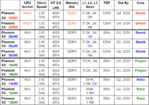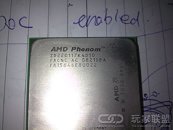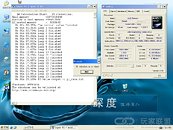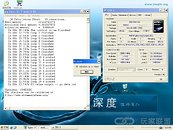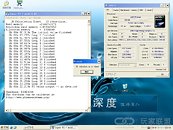
AMD today announced widespread availability of its 45nm Quad-Core AMD Opteron processor, delivering up to 35 percent more performance with up to a 35 percent decrease in power consumption at idle. With IT decision-makers looking to do more with less, the newest Quad-Core AMD Opteron processor can help drive data center efficiencies and reduce complexities with innovations that offer superior virtualization performance and increased performance-per-watt. Global OEMs are expected to immediately offer enterprise and SMB customers more than 25 systems, available between launch today and the end of the year, based on the 45nm Quad-Core AMD Opteron processor, codenamed "Shanghai."

ASUS has published a partial list of motherboards that support the upcoming AM3 socket processors.
Featured in the lists are most motherboards based on the AMD 7-series chipsets, along with those based on GeForce 8 and 7-series chipsets by NVIDIA.
Press release follows:

Intel recently issued a list of the processors it will be phasing out in favour of the new and faster Core i7 CPUs. The list includes several 65nm, 45nm and some laptop processors:
- Q9450 (2.66 GHz 1333 MT/s, quad-core, 95 watt, LGA775, Yorkfield 45nm)
- E8200 (2.66 GHz 1333 MT/s, dual-core, 65 watt, LGA775, Wolfdale 45nm)
- E8190 (2.66 GHz 1333 MT/s, dual-core, 65 watt, LGA775, Wolfdale 45nm)
- E6850 (3.00 GHz 1333 MT/s, dual-core, 65 watt, LGA775, Conroe 65nm)
- E6750 (2.66 GHz 1333 MT/s, dual-core, 65 watt, LGA775, Conroe 65nm)
- E6550 (2.33 GHz 1333 MT/s, dual-core, 65 watt, LGA775, Conroe 65nm)
- E6540 (2.33 GHz 1333 MT/s, dual-core, 65 watt, LGA775, Conroe 65nm)
- E4600 (2.40 GHz 800 MT/s, dual-core, 65 watt, LGA775, Allendale 65nm)
- T7400 (2.16 GHz 667 MT/s, mobile dual-core, 34 watt, Socket-M, Merom 65nm)
- Celeron-M 530 (1.73 GHz mobile, 533 MT/s, single-core, 30 watt, Socket-M, Merom-1024 65nm)
You will still be able to get these items until 2010, but Intel is already taking measures to slowly phase them out from the market.

Industry informer DigiTimes shared today some information on the upcoming Deneb processor family from AMD. According to their information, AMD is planning to launch six high-end 45nm quad-core CPUs (Deneb) and four entry-level (Propus) including 20x00, 18x00, 16x00 and 1xx00e models, in the first quarter of next year. Two of these processors will be available earlier in November of this year - the 3GHz Phenom X4 20550 and 2.8GHz 20350 for socket AM2+ systems.
AMD will also launch six 45nm triple-core CPUs (Heka and Regor) including 14x00, 12x00 and 1xx00e series. These triple-core CPUs will enter design validation test (DVT) and start shipping in the first quarter next year.
In the second and third quarter of next year AMD will also start shipping its 45nm AM3-based dual-core CPUs, part of the Regor family.
Although the chipmaker will largely enter the 45nm generation, in order to prevent potential yield rate problems from the new process, it will launch seven 65nm CPUs including three quad-core Phenom X4 CPUs (Agena) - 9950 (120W), 9850 (95W) and 9450e (65W), and two Athlon X2 CPUs (Kuma) - 7750 and 7550 in the first quarter of 2009, while two low-power Athlon X2 CPUs (Brisbane) - 5050e and 3250e, will launch in the near future.
Launching of the new Phenom processors will also lead to new price reductions and last order notices for some of the older processors. Unfortunately, there is no additional information.

In his keynote today at the Intel Developer Forum in Taiwan, Intel's senior vice president and general manager of Intel's Ultra Mobility Group discussed how technology innovation and strong industry collaboration have driven the digital economy over the past 40 years, and the universal impact that the Internet and mobile Web has had in people's lives. Also highlighted was the progress Intel is making in the Mobile Internet Devices (MID) market segment with the world's first working "Moorestown" platform demonstration. Scheduled for the 2009-2010 timeframe, the Moorestown prototype comprises of an SOC, codenamed "Lincroft," which integrates a 45nm processor, graphics, memory controller and video encode/decode onto a single chip and an I/O hub codenamed "Langwell". Langwell supports a range of I/O ports to connect with wireless, storage, and display components in addition to incorporating several board level functions. The Moorestown platform will support a range of wireless technologies including 3G, WiMAX, WiFi, GPS, Bluetooth and mobile TV. During his keynote Chandrasekher also stated that Intel hopes to revolutionize the MID world with Moorestown when released.


According to sources at server builders, AMD has notified that it would be releasing nine models of quad-core AMD Opteron 45nm processors this month. The processors would be based on the Shanghai core and mark the company's entry into the 45nm silicon fabrication for CPUs.
Out of the
lineup of 20 processors that would come out, the ones slated for this month include CPUs of clock-speeds between 2.3 and 2.7 GHz, of which five of them are 2000 series (2-way) models and the rest, 8000 series (8-way) models. The processors are based on Socket F (s1207) design, and sport 6 MB level 3 caches. The sources also mentioned that in February 2009, AMD will launch five 55W energy-efficient enterprise CPUs, three 2-way and two 8-way; and two 105W high-performance models a 2-way and an 8-way each.

Industry sources report, NVIDIA could be bringing about a massive nomenclature change, departing from its current GeForce 9000 series, to a newer naming system. And we're talking about the brand name here, not the GPU code name (such as G80, G92, G200, etc.) On October 15, the company is rumored to launch new graphics processors under the GT200 series. That's when it is noted that the company breaks away from its current nomenclature for GeForce 9xxx. One of the reasons known so far, is that the company wants to use its transition to the 55nm fab processors as a brand determining factor, easing confusion it has created when products made with the new processors share product names with the current 65nm GPUs.
On to the nomenclature itself, and "GTX 200" would be the series that accommodates extreme performance, enthusiast-grade products. This is already implemented. "GT 200" for high-performance GPUs, followed by "GS 200" for mainstream graphics products, and finally "G200" for entry-level products. Again, we're talking about the model numbers that make it to SKUs, product boxes, etc., not the GPU code-names. Regarding current GeForce 9000 series, they would be rebranded as G100, GT120, GT130, GT140 and GT150, bottom thru top. It is expected that the transition to this new naming system would be completed by Q1 thru Q2, 2009, as that's when NVIDIA is expected to release new enthusiast-grade GPUs based on the even newer 45nm silicon fabrication process.

AMD would be releasing 45nm silicon fabricated series of the quad-core Opteron processor based on the newer Shanghai core. Like its desktop PC counterpart, the Deneb core, it features 6 MB of L3 cache along with some enterprise-specific features. They will be designed for high-uptime and energy efficiency. AMD banks heavily on the performance efficiency and virtualization capabilities of these processors. There are primarily two types of these processors based on the multi-processor capabilities: the 2000 series 2-way processors and the 8000 series 8-way processors. The former supports two-socket systems while the latter is designed for dense 2+ socket environments, where up to 8 Opteron processors could work in tandem. The processors continue to have Socket-F (s1207) interfaces, hence the entire lineup retains its DDR2 memory standard.
Interestingly, AMD did not rework the system interface for all its newer chips. Across the vast lineup of 20 models, only four support the newer HyperTransport 3.0 interface with 4400 MT/s interconnects. The rest continue to use the 2000 MT/s interconnects. It could be mid-2009 by the time AMD
launches its own enterprise-segment chipsets, which could also be the time when the current leading player, NVIDIA launches its newer nForce Professional lineup for the Opteron. Since current chipsets from both NVIDIA and Broadcom feature only the older HyperTransport 2000 MT/s interfaces, it could explain why most of these chips feature it.

AMD would be releasing its first desktop processors based on the 45nm silicon fabrication process, based on the newer Deneb core. The company is said to have made several tweaks to the original K10 design and equipped the core with 300% the amount of L3 cache as its 65nm Agena parts. The only thing got us wondering was what would be its nomenclature like? Well, be surprised to know that after Phenom X4 9000 series, the company plans to continue the numbering with a 5-digit model number scheme with x1000 unit deviations between models. A rather confusing naming scheme, as suggested by the chart provided, seems to have been adopted.
It is now clear, that there will be two distinct kinds of Phenom X4 45nm chips: those which continue support for DDR2 memory on the existing AM2/AM2+ sockets, and those which are exclusive to the AM3 socket and feature support for DDR3 memory, DDR3 1333MHz at that. The processors would feature dual 64-bit memory controllers, which could be ganged for a single 128-bit wide memory interface, or un-ganged to step up multi-tasking efficiency.

Intel has officially begun shipping a 45nm dual-core Intel Atom Processor known as the Intel Atom Processor 330. The newest member of the Atom family is designed specifically for nettops, which are affordable desktops purpose-built primarily for web surfing, email, and basic Internet usage. The dual-core Intel Atom Processor 330 features a 1.6GHz processing core, 1MB of level 2 cache, an 8W TDP and support for DDR2 667. The new processor is available as an integrated package and has been validated with the Intel 945GC Express Chipset, featuring built-in Intel Graphics Media Accelerator 950 and Intel High Definition Audio.

The Intel Core 2 Duo E7000 series has brought in great performance at a low price point. They are basically current 45nm Wolfdale core based processors with 3 MB of L2 cache and 1066 MHz FSB. What it also means that it comes with higher FSB multiplier values to achieve the designated clock speeds. For applications that aren't cache intensive, and for users with appropriate tweaking skills, the E7000 series is a boon. Sources claim that on October 19th, Intel will release the Core 2 Duo E7400 processor, a successor to the current E7300. The release also affects prices across its segment.
The E7400 comes with a 2.80 GHz clock speed. It comes with a FSB multiplier of 10.5x for and 3 MB of L2 cache. Coming to its price, it displaces the E7300 from its current price of US $133 and pushes it down to $113, the E7400 will be priced at $133. In its segment, the E7400 will compete with AMD's Phenom X3 8750 and Phenom X4 9550, though it is expected to perform better than AMD's offerings in that price-range given today's applications.

AMD plans to bring about a gradual transition with its desktop quad-core Phenom chips. Contradicting roadmap slides, Taiwanese industry observer DigiTimes has come up with fresh rumours that AMD could release a pair of AM2+ exclusive Deneb 45nm quad-core processors towards the end of this year. Their clock-speeds could range between 2.60 to 3.00 GHz and TDP ratings at 125W. Meanwhile AM3 designs would surface for manufacturing of both the processors and supportive motherboards that feature DDR3 memory support. It is expected that my May thru June next year, there will be enough AM3 based products in the market for AMD to stop producing any more of these "AM2+ only" Deneb chips. Earlier projections based on company slides showed the two chips coming up in January.

There is a brief insight into what AMD has in store for the desktop CPU market till towards the end of this year. The good news however is that AMD's 45nm conquest flags off by the end of this year. Chile Hardware
published yet another company slide from AMD. This one lists out AMD's desktop processors lined-up for release (both actual and on paper) by the end of this year.
To begin with, AMD will continue to make additions to the Athlon X2 energy-efficient dual-core processors. On October the 2nd, Athlon X2 5050e would be released in both tray and processor-in-[a]-box (PIB) stocks. This processor is rated at 45W and has a clock speed of 2.60 GHz, that's 13.0x 200 MHz. It is based on the Brisbane 65nm core. Later in November, this line would be expanded by the Athlon X2 3250e. This Brisbane-based part comes clocked at 1.50 GHz and a rated TDP of an incredibly low 22W. There's also a single-core part based on the Lima core, the Athlon 2650e, an energy efficient single core rated at 15W with a clock speed of 1.60 GHz.

On September 15th Intel plans to fabricate the Intel Xeon 7400 Dunnington series processor, the company's last Penryn generation processor to be released. Xeon 7400 will mark the end of a previous server era, and after it the new Nehalem Core i7 processor family will start to appear in the fourth quarter. The Xeon 7400 will be Intel's first 6-core server chip. It will be produced using 45nm high-k process technology and will boast 16MB of L3 cache. The Xeon 7400 Dunnington series is also one of the first Intel chips to have a monolithic design, like Nehalem. In other words, all six cores will be on one piece of silicon. To date, for any processor having more than two cores, Intel has put two separate pieces of silicon - referred to as die - inside of one chip package. Server vendors announcing Xeon 7400 powered products will include Sun Microsystems, Hewlett-Packard, Dell, IBM and Unisys, according to Intel senior vice president Pat Gelsinger.

Without doubt, AMD needs something revolutionary to pull it out of the mess it set itself in. AMD's first reaction to the Conroe onslaught was to lower prices and build up a "Smarter Choice" repute, though with successive price cuts from Intel and down-scale products based on the Core architecture coming out by the fortnight, and the transit to 45nm fab process, there's been an increasing need for AMD to get back to the drawing boards with their CPU division.
From what looks like an excerpt from an AMD company slide, can be seen AMD's CPU plans for 2009. The chart broadly shows that K10 architecture is here to stay. Throughout the year, desktop CPUs based on the K10 architecture feature in the roadmap, with no signs of their "truly next-gen" architecture. AMD completes its transit to the 45nm silicon fabrication process and will finally embrace DDR3 system memory standards. To begin with, the fact that the Deneb core's entry slightly steps into the 2008 column shows that the Deneb core-based desktop CPU could release sometime towards the very end of this year. Sources note that two models based on the Deneb core could be out by the end of this year. It supports both DDR2 and DDR3 memory standards and socket compatible with current AM2+ and future AM3. From what's known so far, AM3 is the same 940 pin design that adds pins for the DDR3 memory interconnect between the CPU and the memory.
A new world record has been set today (technically yesterday). Shark OC Team Italy has published the undeniable evidence that their DFI DK P45-T2RS PLUS motherboard and Intel Core 2 Duo E8600 processor are the fastest computer combo to calculate Super PI 1M in just 6.875 seconds. This world record was achieved using the E8600 CPU clocked at the incredible 6562MHz (FSB 656MHz x 10 multi) with 1.968 volts! not the best imaginable core voltage for a 45nm processor. If you are interested at what today's technology is capable of doing, please head over the original thread at
XtremeSystems.com.
Congrats team Italy!

Offering more choice to entry-level desktop PC users, Intel Corporation today showcased a new desktop motherboard that packs a powerful price-performance value proposition. Running on the newly released 45nm dual-core Intel Atom Processor 330, the Intel Desktop Board D945GCLF2 Essential Series is the second generation of Intel's most affordable and differentiated motherboard that integrates a single unit of compute with a microprocessor, chipset, motherboard and heat sink.
Designed to specifically build nettops - a family of affordable desktops purpose built for Internet-centric usage models - the Intel Desktop Board D945GCLF2 targets entry-level computer users in the emerging markets, as second or basic home PCs for mature markets, or customized for unique vertical usage models such as Internet kiosks, thin clients or POS (point-of-sale) systems.

The HyperTransport Consortium released an updated specification, HT 3.1, that increases the base clock speed of the HyperTransport bus from its previous version 3.0 limit of 2600 MHz (5200 MT/s) to 3200 MHz (6400 MT/s). The upcoming 45nm processors will be given a host of architectural updates, one of them being a revised HT 3.1 system bus. Since AMD processors use a 32-bit wide HyperTransport link to the core logic, the aggregate bandwidth of the system but would be raised to 51.6 GB/s (25.8 GB/s in each direction).
This 10 GB/s increment is supposed to favour the upcoming AMD Fusion processors, where a graphics processor would be embedded into the CPU. That could also mean that the CPU could carry PCI-Express switches, effectively eradicating the northbridge. This would mean performance gains with the CPU communicating with PCI-E devices directly instead of through a northbridge-based PCI-E switch, much in the same way as integration of memory controllers five years ago helped AMD processors. It is expected that motherboard vendors have no problems implementing HT 3.1, the AMD 790GX and 790FX chipsets offer native support to HT 3.1 with 45 nm CPUs.

Following the official name scheme confirmation of the Nehalem processors, Intel today also slashed the price of its Core 2 Quad Q9550 (2.83 GHz) CPU by a massive 40% from $530 to $316 in 1000-unit tray quantities. In addition Intel introduced today four new CPUs, confirming the Sunday information posted on our site
here:
- Intel Core 2 Duo E7300 2.66GHz 3MB L2 cache - $133
- Intel Core 2 Duo E8600 3.33GHz 6MB L2 cache - $266
- Intel Core 2 Quad Q9400 (45nm) 2.66GHz 1333MHz FSB 6MB L2 cache - $266
- Intel Core 2 Quad Q9650 (45nm) 3.0GHz 12MB L2 cache - $576
Later on, Intel will release a third Core 2 Quad processor, the Q8200 CPU working at 2.33GHz.

It has been said that Intel is preparing to launch its latest Core 2 Quad processor, the Q8200 on August 31st. The forthcoming processor features four 45nm Penryn cores, 2.33GHz core clock, 4MB of shared L2 cache, a 1333MHz front-side bus, and a suggested price tag of just $203. Specs may be right, but consider the other information a rumor, at least until further info is available.

The newest fleet of quad-core desktop processors from AMD, the Deneb series is tested by Chinese website Zol to consume up to 12 per cent less power compared to equally clocked 65nm Agena parts, add to that, the fact that the 45nm Deneb comes with three times the amount of L3 cache, 6 MB.
The 45nm and 65nm parts were compared on a MSI K9A2 Platinum motherboard with a NVIDIA GeForce GTX 280 card, a single 320 GB HDD, two modules of 1GB DDR2 1066 MHz memory, the test-bed was powered by a Thermaltake Toughpower 1200W PSU. Power consumption was calculated in idle and load (the CPUs were stressed using instances of Orthos).

Shuttle Inc., market leader in the mini-PC segment and manufacturer of Multi-Form-Factor solutions, today unveils a new XPC Barebone from the P2 model series building on Intel's X48 Express chipset. Specially designed for high performance systems, the XPC Barebone SX48P2 Deluxe is ideally suited for Core 2 Duo and Core 2 Quad processors with up to four cores.
The XPC Barebone SX48P2 Deluxe is the first mini PC barebone ready to be equipped with DDR3 memory modules. A maximum capacity of eight Gigabytes on four sockets can be installed into this model. "The pioneering DDR3 memory technology promises more performance with less energy consumption and reduces heat development which is ideal for mini PCs," explains Tom Seiffert, Head of Marketing & PR at Shuttle Computer Handels GmbH. Two PCI Express 2.0 x16 slots enable the use of high-end graphics cards with an ATI Radeon HD 4870 being supported as well.

As we inch closer to the R700 release, which previews prove to have dethroned the GeForce GTX 280 convincingly, taking the crown for the fastest graphics card there is, NordicHardware reports AMD could be giving 'final-touches' to a fresh-wave of GPUs for early 2009. The timing is a critical factor here as that's the time-range the proposed NVIDIA G300 carrying 384 SP's and 512bit GDDR5 memory bus is marked for. The R800 cards could carry 2,000 stream processors, with its unit processors the RV870 holding 1,000 stream processors each. They could enter the realm of either 40nm or 45nm fabrication process.

Pre-release Tests Conducted on AMD Deneb
AMD Deneb is the code-name for the 45nm quad-core CPU which AMD plans to release soon. Chinese website ITOCP got their hands on two engineering samples. They used these samples at various clock-speeds set by altering the FSB multiplier and Vcore voltage. These chips were then subjected to rounds of Super Pi 1M benchmark. The results look rather luke-warm compared to what we saw of the Intel Bloomfield chips recently. The Deneb CPUs were supported by an AMD RD790 motherboard and 2 GB of DDR2 800 MHz unganged memory, running at timings of 5-5-5-18. The Phenom X4 Deneb 45nm will feature 6 MB of L3 cache apart from the usual 512 KB L2 caches dedicated to the cores.

Intel launches the Centrino 2 mobile plaform this Monday, the 14th. Centrino 2, codenamed Montevina is behind launch-schedule owing to issues detected in the integrated graphics controller. The chipset released will be that which supports discrete graphics controllers from ATI or NVIDIA.
Intel Centrino 2 for now is targeted towards the business-class and enterprise segments. The chipset supports DDR3 memory which brings in a certain level of energy efficiency with added performance. At the heart of it would be a 45nm processor based on the Penryn architecture. Initially dual-core processors, with quad-core based notebooks later. The wireless network controller supports the newer 802.11n and WiMAX standards. Security and management features come in through the vPro technology.
These 45nm dual-core processors are said to run at 25W, an efficiency increment over previous generation running at 35W.









